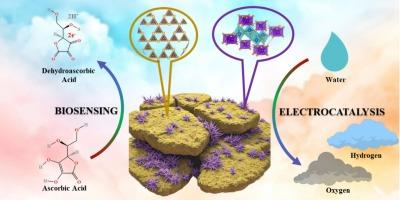新型CoV₂O₆/g-C₃N₄纳米复合材料,用于高效双功能电催化和高性能电化学生物传感
IF 5.1
3区 材料科学
Q2 MATERIALS SCIENCE, COATINGS & FILMS
引用次数: 0
摘要
在清洁能源和敏感生物传感平台双重需求的驱动下,本研究探索了钒酸钴(CoV₂O₆)及其新型石墨氮化碳(g-C₃N₄)纳米复合材料的双功能电催化和生物传感能力。该材料采用原位共沉淀法合成,并通过结构和光谱分析进行了验证。原始的CoV₂O₆呈现出独特的堆叠状饼干状形态,而复合材料显示出两组分之间强烈的界面相互作用。g-C₃N₄含量优化后的样品电化学活性表面积(ECSA)增强,双功能电催化活性增强。具体来说,20% g-C₃N₄/CoV₂O₆复合货号的析氧过电位(η)为153 mV,而40% g-C₃N₄/CoV₂O₆复合货号的析氢过电位仅为178 mV,在商业样品和不同食品提取物中具有较高的灵敏度、稳定性和重复性,具有良好的抗坏血酸生物敏感性能。CoV₂O₆与g-C₃N₄的结合显著改善了载体迁移率和反应动力学,使这些纳米结构复合材料在能量转换和电化学诊断方面具有很大的应用前景。本文章由计算机程序翻译,如有差异,请以英文原文为准。

Novel CoV₂O₆/g-C₃N₄ nanocomposite for efficient bifunctional electrocatalysis and high-performance electrochemical biosensing
Driven by the dual need for clean energy and sensitive biosensing platforms, this study explores bifunctional electrocatalytic and biosensing capabilities of cobalt vanadate (CoV₂O₆) and its novel nanocomposites with graphitic carbon nitride (g-C₃N₄). The materials were synthesized via an insitu co-precipitation method and confirmed through structural and spectroscopic analyses. Pristine CoV₂O₆ exhibited a distinctive stacked biscuit-like morphology, while the composites revealed strong interfacial interactions between both components. Among the samples, those with optimized g-C₃N₄ content displayed enhanced electrochemical active surface area (ECSA) and superior bifunctional electrocatalytic activity. Specifically, 20 % g-C₃N₄/CoV₂O₆ composite achieved a low overpotential (η) of 153 mV for oxygen evolution, while the 40 % g-C₃N₄/CoV₂O₆ composite required only 178 mV for hydrogen evolution and excelled in ascorbic acid biosensing with high sensitivity, stability, and reproducibility in commercial samples and different food extracts. The integration of CoV₂O₆ with g-C₃N₄ significantly improved carrier mobility and reaction kinetics, making these nanostructured composites highly promising for energy conversion and electrochemical (EC) diagnostics.
求助全文
通过发布文献求助,成功后即可免费获取论文全文。
去求助
来源期刊

Diamond and Related Materials
工程技术-材料科学:综合
CiteScore
6.00
自引率
14.60%
发文量
702
审稿时长
2.1 months
期刊介绍:
DRM is a leading international journal that publishes new fundamental and applied research on all forms of diamond, the integration of diamond with other advanced materials and development of technologies exploiting diamond. The synthesis, characterization and processing of single crystal diamond, polycrystalline films, nanodiamond powders and heterostructures with other advanced materials are encouraged topics for technical and review articles. In addition to diamond, the journal publishes manuscripts on the synthesis, characterization and application of other related materials including diamond-like carbons, carbon nanotubes, graphene, and boron and carbon nitrides. Articles are sought on the chemical functionalization of diamond and related materials as well as their use in electrochemistry, energy storage and conversion, chemical and biological sensing, imaging, thermal management, photonic and quantum applications, electron emission and electronic devices.
The International Conference on Diamond and Carbon Materials has evolved into the largest and most well attended forum in the field of diamond, providing a forum to showcase the latest results in the science and technology of diamond and other carbon materials such as carbon nanotubes, graphene, and diamond-like carbon. Run annually in association with Diamond and Related Materials the conference provides junior and established researchers the opportunity to exchange the latest results ranging from fundamental physical and chemical concepts to applied research focusing on the next generation carbon-based devices.
 求助内容:
求助内容: 应助结果提醒方式:
应助结果提醒方式:


